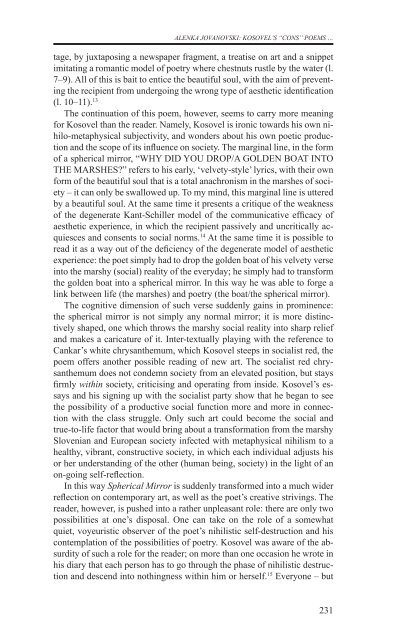razprave (pdf) - Društvo za primerjalno književnost - ZRC SAZU
razprave (pdf) - Društvo za primerjalno književnost - ZRC SAZU
razprave (pdf) - Društvo za primerjalno književnost - ZRC SAZU
- No tags were found...
You also want an ePaper? Increase the reach of your titles
YUMPU automatically turns print PDFs into web optimized ePapers that Google loves.
alenka jovanovski: Kosovel’s “Cons” Poems …tage, by juxtaposing a newspaper fragment, a treatise on art and a snippetimitating a romantic model of poetry where chestnuts rustle by the water (l.7–9). All of this is bait to entice the beautiful soul, with the aim of preventingthe recipient from undergoing the wrong type of aesthetic identification(l. 10–11). 13The continuation of this poem, however, seems to carry more meaningfor Kosovel than the reader. Namely, Kosovel is ironic towards his own nihilo-metaphysicalsubjectivity, and wonders about his own poetic productionand the scope of its influence on society. The marginal line, in the formof a spherical mirror, “WHY DID YOU DROP/A GOLDEN BOAT INTOTHE MARSHES?” refers to his early, ‘velvety-style’ lyrics, with their ownform of the beautiful soul that is a total anachronism in the marshes of society– it can only be swallowed up. To my mind, this marginal line is utteredby a beautiful soul. At the same time it presents a critique of the weaknessof the degenerate Kant-Schiller model of the communicative efficacy ofaesthetic experience, in which the recipient passively and uncritically acquiescesand consents to social norms. 14 At the same time it is possible toread it as a way out of the deficiency of the degenerate model of aestheticexperience: the poet simply had to drop the golden boat of his velvety verseinto the marshy (social) reality of the everyday; he simply had to transformthe golden boat into a spherical mirror. In this way he was able to forge alink between life (the marshes) and poetry (the boat/the spherical mirror).The cognitive dimension of such verse suddenly gains in prominence:the spherical mirror is not simply any normal mirror; it is more distinctivelyshaped, one which throws the marshy social reality into sharp reliefand makes a caricature of it. Inter-textually playing with the reference toCankar’s white chrysanthemum, which Kosovel steeps in socialist red, thepoem offers another possible reading of new art. The socialist red chrysanthemumdoes not condemn society from an elevated position, but staysfirmly within society, criticising and operating from inside. Kosovel’s essaysand his signing up with the socialist party show that he began to seethe possibility of a productive social function more and more in connectionwith the class struggle. Only such art could become the social andtrue-to-life factor that would bring about a transformation from the marshySlovenian and European society infected with metaphysical nihilism to ahealthy, vibrant, constructive society, in which each individual adjusts hisor her understanding of the other (human being, society) in the light of anon-going self-reflection.In this way Spherical Mirror is suddenly transformed into a much widerreflection on contemporary art, as well as the poet’s creative strivings. Thereader, however, is pushed into a rather unpleasant role: there are only twopossibilities at one’s disposal. One can take on the role of a somewhatquiet, voyeuristic observer of the poet’s nihilistic self-destruction and hiscontemplation of the possibilities of poetry. Kosovel was aware of the absurdityof such a role for the reader; on more than one occasion he wrote inhis diary that each person has to go through the phase of nihilistic destructionand descend into nothingness within him or herself. 15 Everyone – but231
















